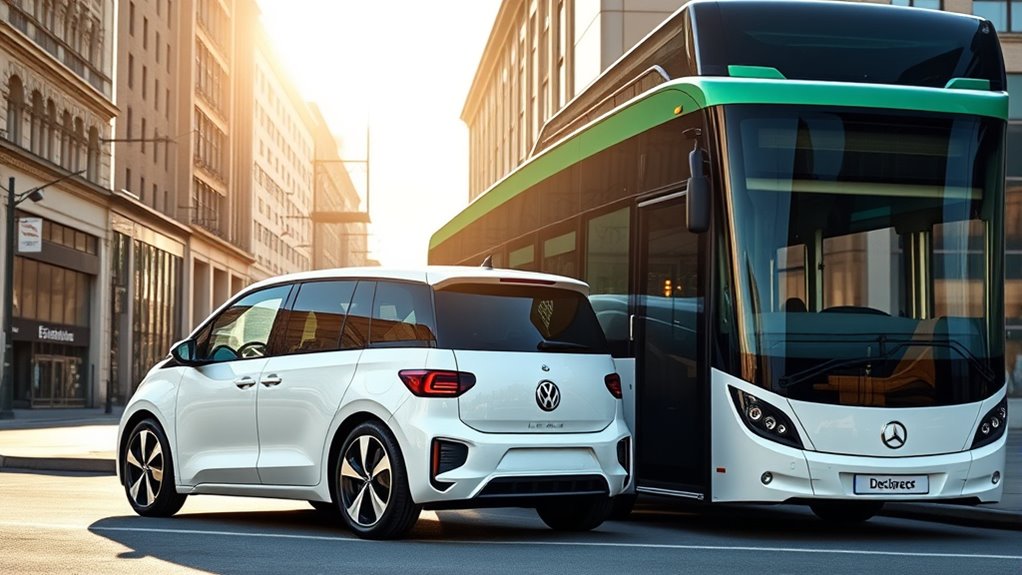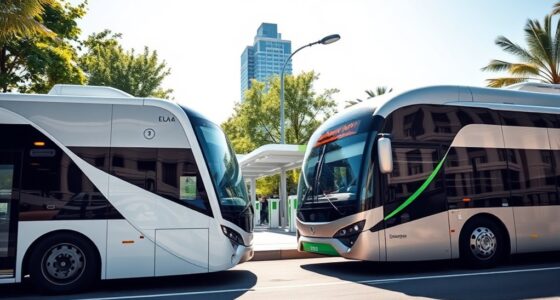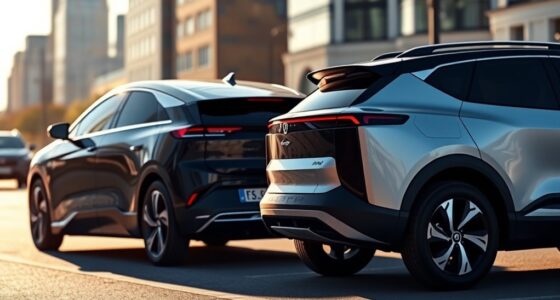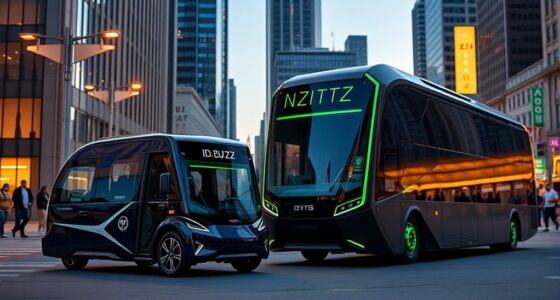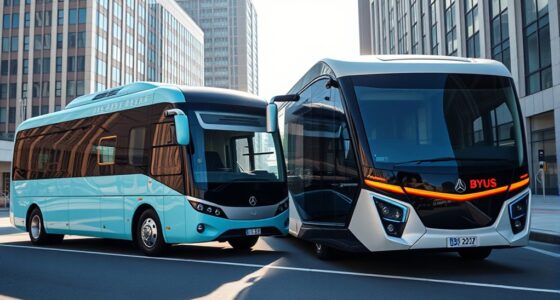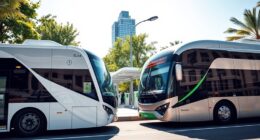The Volkswagen ID.Buzz is a versatile electric minivan perfect for personal use or small groups, offering a range of around 250-300 miles and seating up to seven passengers. In contrast, Daimler’s eCitaro is a city bus designed for urban transit, with a shorter range of about 124-150 miles, but it can carry 70-80 passengers efficiently. If you want to understand how each vehicle suits different mobility needs, there’s more to explore ahead.
Key Takeaways
- The ID.Buzz is a versatile electric minivan designed for personal use with longer-range capability, while the eCitaro is a city bus focused on high passenger capacity and urban transit.
- The ID.Buzz offers approximately 250-300 miles per charge, suitable for longer trips, whereas the eCitaro has a range of about 124-150 miles for city routes.
- The ID.Buzz seats up to seven passengers, ideal for small groups, while the eCitaro accommodates around 70-80 passengers for mass transit.
- The ID.Buzz emphasizes versatility and extended range, whereas the eCitaro prioritizes quick turnaround and high throughput in urban environments.
- Choice depends on operational needs: the ID.Buzz suits personal and longer-distance travel, while the eCitaro is optimized for efficient city transit.

When comparing the Volkswagen ID.Buzz and the Daimler eCitaro, it’s clear that both vehicles represent the future of electric transportation, but they serve different purposes. The ID.Buzz is designed as a versatile minivan perfect for personal use or small group travel, while the eCitaro functions as a city bus built for mass transit. Understanding their differences in electric range and passenger capacity helps clarify which vehicle suits your needs best.
Volkswagen ID.Buzz and Daimler eCitaro: versatile minivan versus city bus for efficient electric transportation.
The ID.Buzz offers an impressive electric range, typically around 250 to 300 miles on a single charge, depending on the variant and driving conditions. This range makes it suitable for longer trips and daily commuting without frequent recharging. Its battery capacity is optimized for versatility, allowing you to enjoy extended drives while maintaining the convenience of fast charging options. In contrast, the Daimler eCitaro’s range is generally more limited, averaging about 124 to 150 miles per charge. Designed primarily for urban routes, it prioritizes quick turnaround times and frequent stops over long-distance travel. Its battery capacity is sufficient for city operations, where drivers can easily recharge during scheduled breaks.
Passenger capacity is another key difference. The ID.Buzz comfortably seats up to seven passengers, making it ideal for family outings, ride-sharing, or small group transportation. Its spacious interior and flexible seating arrangements enhance comfort and practicality for everyday use. The eCitaro, on the other hand, caters to a different scale—its standard configuration can carry around 70 to 80 passengers, depending on the seating layout and standing room. It’s built to maximize capacity and efficiency on busy city routes, where transporting large numbers of people quickly and reliably is essential.
If your needs revolve around personal or small group travel with the flexibility of longer distances, the ID.Buzz’s superior electric range and moderate passenger capacity make it a compelling choice. You’ll benefit from its extended range, which reduces the need for frequent charging, and its adaptable interior that can be tailored to various uses. Additionally, advances in time management apps can help optimize your travel plans and charging schedules, ensuring efficient use of your vehicle’s capacity. Conversely, if you’re involved in urban transit or fleet operations focusing on high passenger turnover, the eCitaro’s design prioritizes capacity and quick charging cycles, making it well-suited for intensive city service.
Ultimately, your choice depends on your specific transportation requirements. The ID.Buzz excels in personal versatility and range, while the eCitaro is built for mass transit efficiency. Both vehicles showcase how electric technology can meet different mobility needs, but understanding their distinct strengths ensures you pick the right one for your journey.
Frequently Asked Questions
What Is the Expected Price Range for Each Vehicle?
For a clear price comparison, you can expect the ID.Buzz to be in the $40,000-$60,000 range, making it relatively affordable for a modern electric minivan. The Ecitaro, being a city bus, typically costs between $150,000 and $200,000. An affordability analysis shows the ID.Buzz offers a more accessible entry point for individual consumers, while the Ecitaro targets fleet operators with higher budgets.
How Do Their Charging and Refueling Options Compare?
You’re in for a treat when comparing their charging and refueling options. The ID.Buzz benefits from widespread charging infrastructure, making top-ups quick and convenient, especially with fast-charging capabilities that enhance fuel efficiency. On the other hand, the Ecitaro relies on traditional refueling, which might take longer but guarantees a reliable fuel supply. It’s a classic case of having your cake and eating it too, depending on your needs.
What Are the Maintenance Costs for Each Model?
You’ll find that maintenance costs for the ID.Buzz are generally lower due to its simpler electric drivetrain, which reduces wear and tear. The Ecitaro, while also electric, may have higher costs because of its extensive city bus features. Both models offer solid warranty coverage that includes battery lifespan, giving you peace of mind. Regular maintenance is still essential, but electric vehicles tend to need less frequent repairs overall.
How Do Safety Features Differ Between the Two?
Ever wondered which vehicle keeps you safer on the road? The ID.Buzz offers advanced safety technology like automatic emergency braking and lane-keeping assist, focusing on accident prevention. The Ecitaro, meanwhile, emphasizes robust structural safety and driver assistance systems tailored for city driving. While both prioritize safety, Volkswagen’s model leans heavily on innovative safety tech, giving you peace of mind, whereas Daimler’s bus emphasizes structural integrity for passenger safety.
What Is the Passenger Capacity and Interior Flexibility?
You’ll find that the ID.Buzz offers flexible interior customization, accommodating up to seven passengers with adjustable seating arrangements for comfort and cargo space. The Ecitaro typically seats around 30 to 40 passengers, optimized for urban transit, with limited interior flexibility. Your choice depends on whether you need a versatile minivan for smaller groups or a larger city bus for mass transit, each designed for specific passenger capacities.
Conclusion
While some might think the ID.Buzz is better suited for personal use and the Ecitaro for city transit, both vehicles excel in their roles. The ID.Buzz offers versatility and a nostalgic vibe, but the Ecitaro’s efficiency and design make it a top choice for urban buses. Don’t overlook the Ecitaro just because it’s a bus—its innovation proves it’s also a smart, sustainable option worth considering for city fleets.
